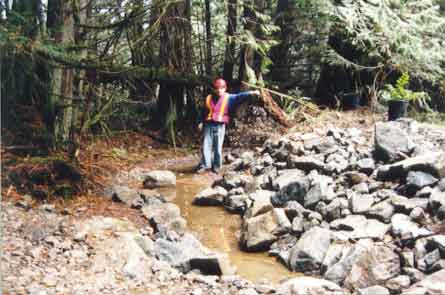
Large boulders or riprap armour the stream bank and change the direction of water flow, creating instream habitat.
Techniques
Rock toe keys are used to shore up erosion-prone sites at the toe of the bank. Installation requires excavation of the channel bed at the toe, and placement of large hard angular rocks below the level of erosion.Riprap and rock revetements use a layer of large angular rocks placed in the bank zone to armour banks and prevent erosion. Riprap should not be placed on steep slopes (those with a slope ratio greater than 1.8 unit horizontal to 1 unit vertical), and should be placed on a filter layer of well-graded rock at least 20 cm thick or geotextile fabric if the bank material is predominantly silt or clay.

Groynes can redirect flow towards the middle of the stream channel. These structures are attached to one bank and placed low in the water (usually at high flow and oriented upstream). They should not be used in entrenched or steep streams, or those less than 10m wide.
Turning rocks redirect, slow flow, and create eddies to improve fish habitat. Boulders placed in a diagonal row downstream across a stream bend serve to diminish erosion on the outside bank. Several rows of 5 to 10 turning rocks are required. Do not use in steep streams or streams exceeding 20 - 30m width.
Tie-backs protect a straight section of a stream bank from the lateral migration of the thalweg. Lengths of rock revetment are perpendicularly extended up the streambank onto the floodplain. These are most effective when used in conjunction with rock toe keys or vegetative methods and when placed at the endpoints of a rehabilitated section. Do not use tie-backs in steep or migrating streams.
Advantages of rock methods
-can be used to engineer undercuts for habitat
-gaps in riprap and boulder constructions create in-stream cover
-when planned well, they are durable and lasting
Disadvantages of rock methods
-can be very expensive
-large projects can require much labour and use of heavy equipment
-require regular maintenance and inspection
-poorly planned projects i.e. improper choice of boulder size, may result in downstream habitat disruption due to dislocation of material
© 2009 Veins of Life Watershed Society / All Rights Reserved / if you wish to use any info for commercial or non commercial usage you must obtain permissions from The Veins of Life Watershed Society